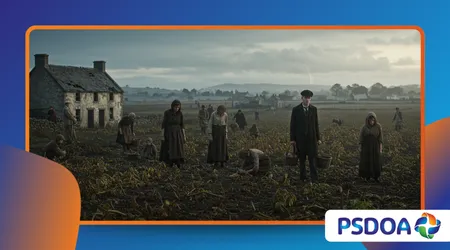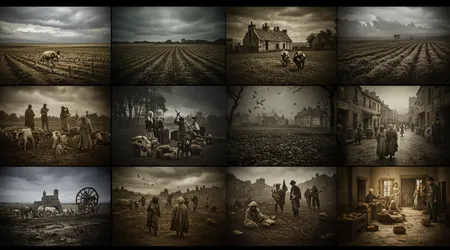The Great Famine: Causes and Cover-Ups

The devastating period in Ireland between 1845 and 1849, commonly known as The Great Famine (or An Gorta Mór), transcends a simple environmental disaster.
Anúncios
While the immediate cause was the Phytophthora infestans potato blight, the catastrophe’s true scale was determined by political choice and systemic neglect.
This chapter in hidden history reveals a complex interplay of colonial vulnerability, rigid economic ideology, and a disturbing lack of humanitarian urgency from the governing power. Millions died or emigrated, permanently scarring the Irish demographic and political landscape.
Examining this event not merely as a consequence of nature, but as a crisis amplified by policy, is crucial for historical accuracy. We must confront the uncomfortable truths of why food continued to leave Irish ports as its people starved.
The enduring legacy of The Great Famine demands a deeper scrutiny of the political decisions that turned crop failure into mass starvation and depopulation.
Anúncios
What Factors Transformed a Blight into a Catastrophe?
The potato blight, which struck across Europe in the 1840s, caused significant hardship everywhere, yet only in Ireland did it result in such apocalyptic death rates.
Why Was Ireland So Vulnerable to Crop Failure?
By the mid-19th century, Irish tenant farmers, often landless laborers, depended almost exclusively on the potato for sustenance. Colonial land policies had forced millions onto small, densely populated plots of marginal land.
The efficiency of potato cultivation allowed this large population to survive on minimal acreage, but it created a dangerous monoculture. This overwhelming reliance on a single, genetically similar crop made the entire food system structurally weak against a widespread disease like the blight.
When the blight arrived from North America in 1845, and decimated the harvest of 1846, there was no affordable, secondary food source available for the poorest classes. This systemic reliance made The Great Famine almost inevitable once the blight hit.
++ The Untold History of Pre-Columbian America
How Did Colonial Land Ownership Exacerbate the Crisis?
The vast majority of productive land was owned by Anglo-Irish landlords, who prioritized commercial exports, not local sustenance. Most tenants paid rent not with money, but with grain, dairy, and livestock.
This meant that even as the potato crop failed, trains and ships laden with wheat, oats, beef, and butter continued to leave Ireland for Britain. This constant, enormous export of food highlighted the policy-driven nature of the starvation during The Great Famine.
The inability of the starving population, who lacked cash, to purchase the abundance of non-blighted food surrounding them represents the ultimate failure of colonial economic structure. The systemic dispossession of the Irish from their land was the foundational crisis.

What Were the Policy Decisions That Led to Mass Death?
The response from the British government, guided by rigid laissez-faire economic dogma, is widely considered the critical factor in accelerating the mortality rate.
Why Did the British Government Adopt a Policy of Non-Interference?
Lord John Russell’s Whig government, which took power in 1846, adhered strictly to the belief that the market must not be interfered with. They viewed government intervention as economically unsound and morally counterproductive.
Also read: Unearthing the Gallus Revolt: Coins and Tunnels of Resistance in Roman Galilee
How Did Laissez-Faire Ideology Become a Weapon?
Sir Charles Trevelyan, who directed relief efforts, famously believed the famine was a “judgement of God” intended to “teach the Irish a lesson” in self-reliance and industry. This evangelical, prejudiced view justified a minimal and often cruel response.
The initial public works schemes, forcing starving men to labor for meager wages often less than the cost of food, achieved little and were riddled with corruption. These schemes failed to feed the most vulnerable, dramatically increasing the death toll in the winter of 1846-47, known as “Black ’47.”
This ideology meant the government refused to ban the export of Irish-grown grain, nor did it purchase enough foreign corn to stabilize prices significantly. The priority remained sound financial policy over humanitarian crisis management.
Statistic: Historian Cormac Ó Gráda noted that while the British government spent an estimated £8 million on relief efforts, a comparable amount (£20 million) was spent to reimburse slave owners following the abolition of slavery in 1833, and vastly more (£69 million) was spent on the Crimean War a decade later, underscoring the inadequate financial priority given to The Great Famine.
Read more: Forgotten Maritime Empires of the Ancient World
What Was the Impact of the Poor Law Extension Act?
The 1847 Poor Law Extension Act made Irish landowners fully responsible for financing local famine relief. This policy incentive immediately encouraged mass evictions.
Landlords, facing financial ruin, cleared their estates of small tenant farmers to consolidate land for more profitable cattle grazing. Hundreds of thousands were forcibly evicted, contributing directly to the death toll and mass emigration.
The Role of Export and Eviction in the Cover-Up
The ‘cover-up’ was not a secret conspiracy but a systematic political narrative designed to minimize the government’s culpability and shift the blame entirely to nature.
Was There a Systematic Denial of Food Scarcity?
Yes, the British Parliament, dominated by wealthy landowners, continually insisted that sufficient food stocks existed within Ireland. They often discounted evidence of mass starvation, citing anecdotal failures in distribution rather than a fundamental policy failure.
How Did Food Exports Become a Symbol of Injustice?
During the worst years of The Great Famine, food exports from Ireland remained incredibly high. These exports were not ‘secret,’ but were a shocking, visible sign of a system that prioritized property rights over human life.
This continued stream of exported food, passing starving people on the roads, became the enduring symbol of colonial inhumanity and proof of a policy failure. The argument was, fundamentally, that this was a famine of money, not a famine of food.
Example: In 1847, the worst year, records show grain, livestock, and dairy products worth millions of pounds sterling were exported from Ireland. Meanwhile, weakened victims died on the side of the roads attempting to walk to workhouses.
What Lasting Damage Did Mass Eviction Inflict?
The mass evictions permanently reshaped the Irish social structure. The poorest class of landless laborers and smallholders was systematically eliminated through death and forced emigration.
The widespread destruction of homes and the brutal clearance of estates cemented the image of the landlord as the executioner, directly serving the interests of British policy. The trauma of eviction remains a profound and painful memory tied to the narrative of The Great Famine.
The Enduring Legacy and Analogies in Modern Crises
The Irish experience provides a potent historical warning against allowing rigid ideology to dictate the response to humanitarian crises.
Why Does the Famine Remain Relevant in 2025?
The historical parallel is clear: when natural disaster meets extreme socio-economic vulnerability and a non-responsive political framework, the disaster becomes a genocide of policy.
What Modern Crises Mirror the Famine’s Dynamics?
Analogia: The Great Famine in Ireland was like a lifeboat carrying two people one rich, one poor when a hole opens. The rich person refuses to bail water, insisting that the law of the market forbids intervention, and furthermore, suggests the poor person is simply too lazy to swim. The structural problem, exacerbated by the refusal to act, is the core lesson.
The current global food insecurity crises often display similar dynamics, where food availability is high, but access is prevented by conflict, poverty, and political inaction. Recognizing the political dimension of famine is the most vital lesson for the contemporary world.
Example: The British refusal to close the ports or interfere with trade, seeing starvation as a market correction, mirrors arguments against aid in modern times. This refusal to prioritize human life over economic theory is the core of the hidden tragedy.
Demographics and Loss During The Great Famine (1841-1851)
| Metric | Pre-Famine (1841 Census) | Post-Famine (1851 Census) | Change |
| Population | 8.17 Million | 6.55 Million | -1.62 Million |
| Estimated Deaths | N/A | Approx. 1 Million | N/A |
| Estimated Emigration | N/A | Approx. 1–2 Million | N/A |
Conclusion: Remembering a Political Famine
The Great Famine was a period of catastrophic crop failure whose effects were catastrophically amplified by human governance and colonial cruelty.
The immense death toll estimated at one million and the permanent reduction of the population by over 20% due to death and emigration were not inevitable.
They were the direct result of adhering to rigid, prejudiced policies that prioritized colonial land ownership and laissez-faire economics over the lives of millions of subjects.
The historical record shows that food was available; political will was not. Should historians continue to avoid labeling this a genocide of neglect, given the systematic policy decisions?
How can modern governments ensure that ideology never again supersedes the ethical imperative to feed their most vulnerable populations? Share your thoughts and any personal family history connected to this period in the comments below.
Frequently Asked Questions (FAQ)
Q: Why is it often called “The Great Hunger” and not just a famine?
A: The term “The Great Hunger” (An Gorta Mór in Irish) emphasizes the prolonged, brutal starvation and disease, but also highlights that it was an artificial famine.
Since non-blighted food was being exported, the hunger was caused by political systems, not simply a total lack of food.
Q: Did the British government provide any relief at all?
A: Yes, under Prime Minister Sir Robert Peel (pre-1846), the government did import Indian corn and set up relief commissions, which helped mitigate the initial blighted harvest. However, relief was severely curtailed when Lord John Russell took over and adopted the fatal laissez-faire ideology.
Q: How did the famine permanently change Ireland?
A: The Great Famine led to a century of continuous population decline due to mass emigration, a radical shift from tillage to pasture (cattle), and a political awakening that fueled Irish nationalism and independence movements. It fundamentally altered the nation’s cultural and economic DNA.
